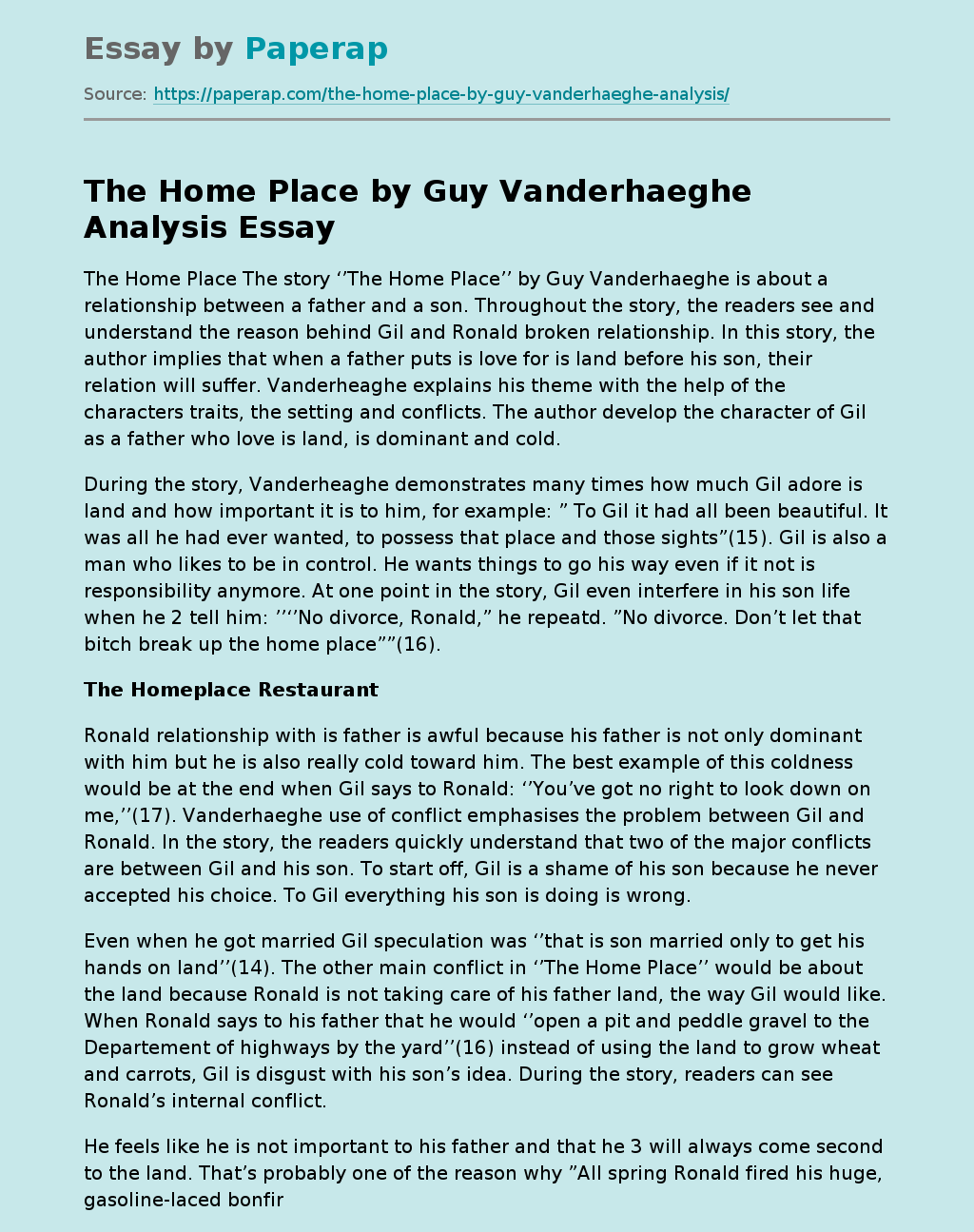The Home Place The story ‘’The Home Place’’ by Guy Vanderhaeghe is about a relationship between a father and a son. Throughout the story, the readers see and understand the reason behind Gil and Ronald broken relationship. In this story, the author implies that when a father puts is love for is land before his son, their relation will suffer. Vanderheaghe explains his theme with the help of the characters traits, the setting and conflicts. The author develop the character of Gil as a father who love is land, is dominant and cold.
During the story, Vanderheaghe demonstrates many times how much Gil adore is land and how important it is to him, for example: ” To Gil it had all been beautiful. It was all he had ever wanted, to possess that place and those sights”(15). Gil is also a man who likes to be in control. He wants things to go his way even if it not is responsibility anymore.
At one point in the story, Gil even interfere in his son life when he 2 tell him: ’’‘’No divorce, Ronald,” he repeatd. ”No divorce. Don’t let that bitch break up the home place””(16).
The Homeplace Restaurant
Ronald relationship with is father is awful because his father is not only dominant with him but he is also really cold toward him. The best example of this coldness would be at the end when Gil says to Ronald: ‘’You’ve got no right to look down on me,’’(17). Vanderhaeghe use of conflict emphasises the problem between Gil and Ronald.
In the story, the readers quickly understand that two of the major conflicts are between Gil and his son. To start off, Gil is a shame of his son because he never accepted his choice. To Gil everything his son is doing is wrong.
Even when he got married Gil speculation was ‘’that is son married only to get his hands on land’’(14). The other main conflict in ‘’The Home Place’’ would be about the land because Ronald is not taking care of his father land, the way Gil would like. When Ronald says to his father that he would ‘’open a pit and peddle gravel to the Departement of highways by the yard’’(16) instead of using the land to grow wheat and carrots, Gil is disgust with his son’s idea. During the story, readers can see Ronald’s internal conflict.
He feels like he is not important to his father and that he 3 will always come second to the land. That’s probably one of the reason why ”All spring Ronald fired his huge, gasoline-laced bonfires of scrub oak and poplar’’(16). Destroying the land is the only way Ronald can use to get even with his father for making him feel that way. The details that Vanderhaeghe uses to describe the setting demonstrate the love that Gil has for his land. This story takes place mainly on the family land. The Home place is special to Gil “Situated in a valley’’ (14) and ‘’down by the river’’ (14).
The home place also have a beautiful land that ‘’consisted of the original quarter Gil’s father had homesteaded, the pre-emption, and another 320 acres picked up cheap from a Finnish immigrant’’ (14). The farm is everything Gil ever wanted and a day away from all the beautiful sights the farm has to offer made Gil restless. Another important part of the setting is the broken fences Gil wanted to repair because ‘’the wires were rotten with rush’’ (17) and ‘’They were a disgrace’’ (14).
The fact that Gil wants to repair the fences so badly makes the readers understand how attach he is to the land and how important the image of the farm is. Even dough the land is no longer his, he still wants to be proud of the land he gives to his son. In conclusion, the author made it clear that Gil would have given up anything for his land. He never had a relationship with it son, Ronald, because he was too preoccupied with the home place to give him any attention. Gil is also someone who needs to be in charge but Ronald still want against his wishes when he got married and started to destroy the land. Ronald’s father never had any respect for is son and that’s one of the reason why they were so many conflict between the two of them.
The Home Place by Guy Vanderhaeghe Analysis. (2019, Dec 05). Retrieved from https://paperap.com/the-home-place-by-guy-vanderhaeghe-analysis/

